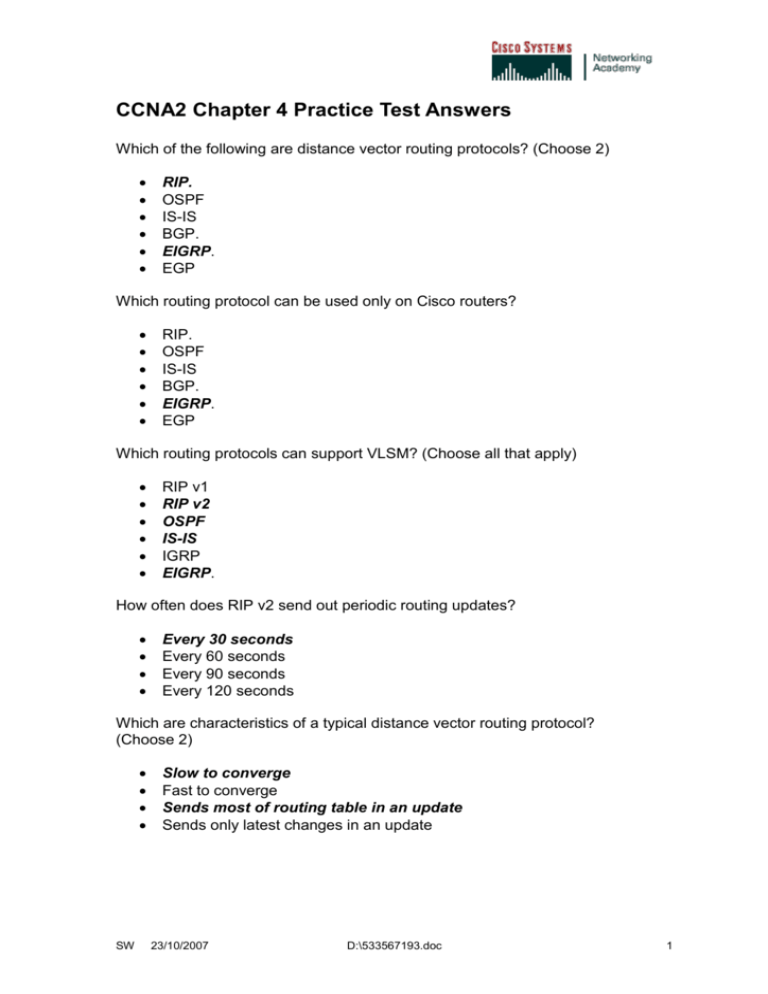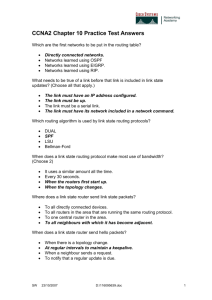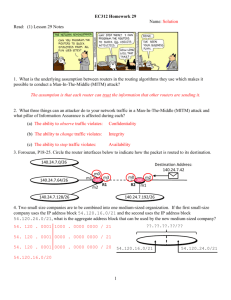PQ4a
advertisement

CCNA2 Chapter 4 Practice Test Answers Which of the following are distance vector routing protocols? (Choose 2) RIP. OSPF IS-IS BGP. EIGRP. EGP Which routing protocol can be used only on Cisco routers? RIP. OSPF IS-IS BGP. EIGRP. EGP Which routing protocols can support VLSM? (Choose all that apply) RIP v1 RIP v2 OSPF IS-IS IGRP EIGRP. How often does RIP v2 send out periodic routing updates? Every 30 seconds Every 60 seconds Every 90 seconds Every 120 seconds Which are characteristics of a typical distance vector routing protocol? (Choose 2) SW Slow to converge Fast to converge Sends most of routing table in an update Sends only latest changes in an update 23/10/2007 D:\533567193.doc 1 What information does a distance vector routing protocol have about the group of networks where the protocol is running? It builds up a picture of all routers and links in the group of networks. It knows only about its directly connected neighbours. It knows which routers a packet must pass through to reach the destination networks that it has discovered. It knows which port to use to reach destination networks and a measure of the distance to each network. The routers are running RIP v2. Router D sends an update to Router B with the information that the link to network 202.13.4.0 is down. Which of the following is true? Router B will include the information in its updates to routers A, C and D. Router B will include the information in its updates to routers A and D. Router B will include the information in its updates to routers A and C. Router B will not include the information in its updates. A router is running RIP v1. What regular routing updates will it send? SW A broadcast of its full routing table to its immediate neighbors. A broadcast of its full routing table to all RIP routers in the network group. Unicast messages of its full routing table to known neighbours. Limited updates containing only information about recent changes, broadcast to all routers. Limited updates containing only information about recent changes, directed to routers that need the information. 23/10/2007 D:\533567193.doc 2 If RIP v1 and EIGRP were both running on the networks in the diagram, why would they choose different routes for forwarding a packet from A to D? Because they have different administrative distances. Because RIP uses hop count as its metric and EIGRP uses a metric where bandwidth is important in the calculation. Because RIP learns only about one path and EIGRP learns about alternative paths. Because RIP v1 is classful and EIGRP is classless. What happens to the routing table when a router is switched off? The information is saved in flash memory. The information is automatically saved in NVRAM. There will be a prompt to remind the administrator to save the information to NVRAM. The information is lost. What is a triggered update? A regular timed update, triggered by the update timer. An update sent in response to some change in the network topology, in addition to the regular updates. An update of the type sent by link-state routing protocols, but not by distance vector routing protocols. An update sent in response to a request from a neighbour router. What is the purpose of triggered updates in RIP? SW They help to reduce use of bandwidth. They help to speed up convergence. They help routers to select more efficient routes. They ensure that updates are sent only to the right destinations. 23/10/2007 D:\533567193.doc 3 When a router is switched on after some down time, what routes will appear in the routing table before it receives any updates from neighbours? All the routes from the old routing table that were saved before the router was switched off. No routes will appear until an update is received. A directly connected route will appear for the network attached to each router interface. A route will appear for each network connected to an active interface with an IP address configured, and for any configured static routes. 202.23.4.1 All routers are using RIP. Router B’s routing table shows a path to network 202.23.4.0 with a hop count of 1. Router B sends a routing update to Router C. What happens to the hop count for network 202.23.4.0? It is shown in Router C’s routing table just as it was in Router B’s. It is decremented by 1 and shown in Router C’s routing table. It is incremented by 1 and shown in Router C’s routing table. Router C will ignore it and calculate its own hop count. Router C will not show the route to 202.23.4.0 in its routing table. Router C has learned a RIP route to 202.23.4.0 from router B. Router C now sends an update to router B. What happens? SW Under the split horizon rule, router C will not include the route to 202.23.4.0 in its update. Router C will include the route to 202.23.4.0 in its update, but decrease the hop count by 1. Router B will wait until its holddown timer expires before accepting the information in the update from C. Router B will ignore the information about the route, but pass it on unchanged to router A. 23/10/2007 D:\533567193.doc 4 Why is the RIP update timer altered by a small random time whenever it is reset? To reduce the use of bandwidth by sending fewer updates. To reduce the risk of congestion and collisions if several routers start up at the same time and send updates. To speed up convergence. To ensure that routers that are already operating have a chance to send their updates first. What metric does RIP use to indicate a route that has become invalid? 0 15 16 99 100 Both RIP and EIGRP are enabled on all routers. A route to 202.23.4.0 is shown in Router A’s routing table. Using default settings, will it be the route discovered by RIP or the route discovered by EIGRP? RIP because it has a greater administrative distance than EIGRP RIP because it has a smaller administrative distance than EIGRP EIGRP because it has a greater administrative distance than RIP EIGRP because it has a smaller administrative distance than RIP When is a distance vector network said to be converged? When all routers have identical routing tables When all routers have consistent routing tables When all links and devices are fully functional When routing updates are being exchanged What makes EIGRP unlike a typical distance vector routing protocol? (Choose 2) It is fast to converge. It broadcasts its complete routing table to neighbours. It sends information about changes, but not complete routing tables. It uses more bandwidth. Which of the following are mechanisms used by distance vector routing protocols to avoid routing loops? (Choose all that apply.) SW Count to infinity Route poisoning Administrative distance Split horizon 23/10/2007 D:\533567193.doc 5 Update timer Holddown timer Router B is running RIP. It uses route poisoning to alert other routers that the link to 192.168.2.0 has gone down. What does it do? It leaves 192.168.2.0 out of its next update. It advertises the route to 192.168.2.0 with a metric of 16. It advertises the route to 192.168.2.0 with an administrative distance of 255. It advertises an alternative route with a larger hop count to 192.168.2.0. What will EIGRP do if its best calculated route to a destination passes through 16 routers? It will detect that the route is invalid. It will install the route in its routing table because EIGRP does not use hop count as a metric or set a limit of 16 hops. It will advertise the route to its neighbours with a hop count of 17. EIGRP does not use hop count as a metric and therefore it will not detect this route. Why is fast convergence a desirable characteristic of a routing protocol? Routers will not forward packets until the network is converged. Converged networks provide shorter and more efficient routes. Routers may have incorrect information in their routing tables if the network is not yet converged. Once the network is converged, the routers will no longer need to send routing updates. What would happen to a packet caught in a routing loop if all the distance vector mechanisms for avoiding such loops failed? It would loop endlessly, taking up bandwidth on the networks. Eventually the TTL field in its packet header would fall to 0 and the packet would be dropped. Eventually the packet would reach the edge of the autonomous system and be dropped. A router receiving the packet for a second time would automatically drop it. Which routing algorithm does EIGRP use? SW Bellman-Ford DUAL Dijkstra Shortest Path First 23/10/2007 D:\533567193.doc 6 How can you identify an EIGRP route in a routing table? It is marked with E It is marked with D It is marked with R It is marked with I Why might RIP be preferred to EIGRP for a small network with simple topology? RIP uses less bandwidth RIP is less prone to routing loops RIP has a more efficient routing metric RIP has a more efficient routing algorithm RIP is simple to configure and administer What is the name given to the feature of RIP that limits the valid metric to 15 and helps to avoid routing loops? Count to infinity Route poisoning Administrative distance Split horizon Update timer Holddown timer 202.23.4.1 The routers are using RIP and network 202.23.4.0 has just been connected to router A. How is router D most likely to become aware of a route to 202.23.4.0? Through a regular broadcast update from A. Through a triggered update from A. Through a regular broadcast update from C. Through a triggered update from C. Router B has a route that it learned from A in its routing table. The latest update from A does not include the route. What does Router B do? Immediately removes the route from its routing table and informs other routers. Does nothing until it receives notification that the route is back up. Sets a hold-down timer and waits for it to expire before marking the route as down SW 23/10/2007 D:\533567193.doc 7 Sends a message back to the source of the information asking for confirmation Router B has a route that it learned from A in its routing table. Router A is no longer including this route in updates. How long will it be by default before Router B removes the route from its routing table? 60 seconds – it waits for two updates to come. 180 seconds – it waits for the holddown timer to expire. 180 seconds – it waits for the invalid timer to expire. 240 seconds – it waits for the flush timer to expire Where would RIP v2 be a better choice than RIP v1? (Choose 2) On a large hierarchical network. Where authentication is needed. Where fast convergence is needed. Where different sized subnets have been used. An administrator displays the routing table and finds that it includes the following information: 192.168.1.0/24 [120/3] via 203.13.3.2, 00:00:10, serial 0/0 What routing protocol is being used, assuming that all values are defaults? RIP IGRP OSPF EIGRP BGP Router B has received an update suggesting that the route to 192.168.9.0 is down. It has set a holddown timer on the route. What event will cause the holddown timer to be removed? An update arrives containing a new route to 192.168.9.0 with a greater metric. An update arrives containing a new route to 192.168.9.0 with a smaller metric. An update arrives and the route to 192.168.9.0 is not included. A packet arrives addressed to a host on the 192.168.9.0 network. Which RIP timer expires and causes a route to be given a metric of 16? SW Update timer Holddown timer Invalid timer Flush timer 23/10/2007 D:\533567193.doc 8









